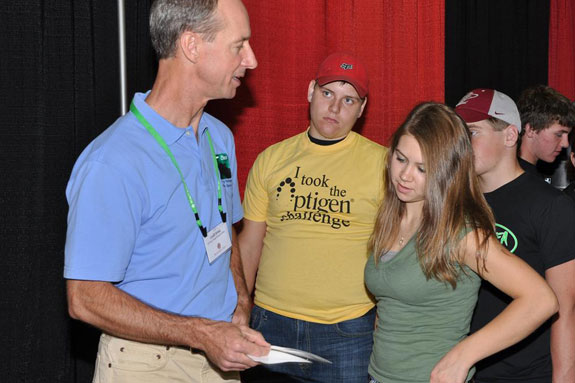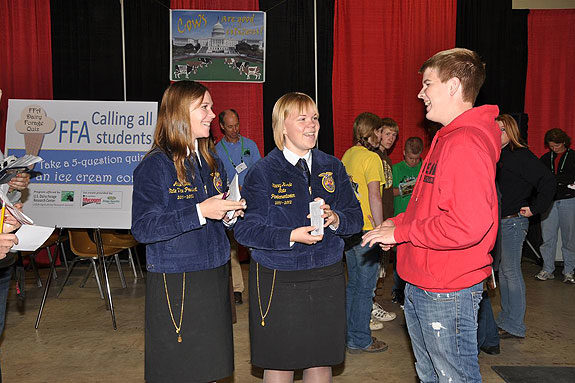FFA students were given a chance to answer questions relating to the dairy and forage industry to win an ice cream cone sponsored by Mycogen Seeds. Organizers estimate 800 FFA students took the quiz, and they look forward to holding the event again next year.
Can you pass the quiz? Test your knowledge with the questions below (answers are at the bottom of the page, but no cheating!).
Post a comment to tell us how many you got right – we’ll hold a drawing for a newly-designed Progressive Forage Grower hat from all those that participate (no matter how many you get right) by posting your results as a comment before November 28, 2011.
FFA Dairy Forage Quiz
1. Research at the U.S. Dairy Forage Research Center has helped U.S. dairy farmers (combined, as a whole) save more than:
a. $585,210 per year
b. $2.8 million per year
c. $9.7 million per year
d. $1.5 billion per year
2. Where does Wisconsin rank in milk production in the U.S.?
a. First
b. Second
c. Third
d. Fourth
3. Which is NOT a forage legume?
a. Alfalfa
b. White clover
c. Timothy
d. Red clover
4. Which state is first in alfalfa silage and green chop production?
a. Arizona
b. Utah
c. Florida
d. Wisconsin
5. What does BMR stand for when referring to corn silage hybrids?
a. Big midrib
b. Better milk results
c. Brown midrib
d. Bovine milk reducer
6. The U.S. Dairy Forage Research Center is located in:
a. Las Vegas, Nevada
b. Washington, D.C.
c. Madison, Prairie du Sac and Marshfield, Wisconsin
d. Springfield, Illinois and Lexington, Kentucky
7. Which is NOT a compartment in a cow’s stomach?
a. Rumen
b. Reticulum
c. Omasum
d. Pancreas
8. Silage fermentation stops, and the feed is preserved:
a. As soon as crop is packed
b. In 4-7 days
c. When the crop reaches 212ºF
d. Only when the silage freezes
9. Which state produces the most hay?
a. New Hampshire
b. California
c. Nevada
d. Kentucky
10. Which is NOT true about alfalfa?
a. Farmers in California can grow 8-10 crops a year
b. Its roots can grow 20+ feet deep
c. Its protein content declines as the plant matures
d. It requires nitrogen fertilizer annually
11. Which scientists are NOT found at the U.S. Dairy Forage Research Center?
a. Geologist, meteorologist
b. Chemist, soil scientist
c. Agronomist, plant geneticist
d. Dairy scientists, microbiologist
12. Which animal is NOT a ruminant?
a. Pig
b. Giraffe
c. Cow
d. Deer
13. Which state produces the most alfalfa per acre?
a. South Carolina
b. Louisiana
c. California
d. Arkansas
14. Which statement is true about the timing of alfalfa harvests?
a. Should be harvested at 75% flower
b. Is based on the calendar, not plant maturity
c. Cuttings should always be 10 days apart
d. Forage yield increases and forage quality declines as plant matures
15. When was the brown midrib (BMR) gene mutation discovered in corn?
a. 1832
b. 1924
c. 2003
d. 2009
16. World Forage Analysis Superbowl entries come from:
a. Wisconsin only
b. Custom haymakers only
c. 20 to 30 states in the U.S.
d. 50 states and 21 countries
17. Which statement is true?
a. Wisconsin ranks first in milk, California first in cheese
b. California ranks first in milk, Wisconsin first in cheese
c. California ranks first in milk and cheese
d. Wisconsin ranks first in milk and cheese
18. Which state is first in milk production per cow?
a. Georgia
b. Vermont
c. North Carolina
d. Washington
19. Which grass is used the least for dairy grazing in the Great Lakes states?
a. Switchgrass
b. Fescue
c. Ryegrass
d. Bluegrass
20. Which two amino acids are most limiting in a typical dairy cow diet?
a. Plasma and Oxytocin
b. Valine and Asparagine
c. Phosphorus and Potassium
d. Methionine and Lysine
21. Which is NOT true about feeding forage to dairy cows?
a. Forages stimulate cud chewing and rumination which improve appetite
b. Forages are often the only source of fiber in a cow’s diet
c. Legumes can provide up to 75 percent of protein needed by lactating cows
d. Dairy cow diets should be 1 part forage to 3 parts grain (by volume)
22. Which measure of forage quality is most related to digestibility?
a. Percent fat
b. Non-Dairy Fiber (NDF)
c. Percent dry matter
d. Neutral Detergent Fiber (NDF)
23. How does BMR corn silage differ from conventional corn silage?
a. Lower lignin, lower digestibility
b. Lower lignin, higher digestibility
c. High lignin, lower digestibility
d. Higher lignin, higher digestibility
24. Which is NOT true about rumen microbes (bacteria and protozoa)?
a. There are eight known species
b. They help cows digest fiber
c. They are a good source of protein for the cow
d. They need warmth and moisture to survive
25. What percent of a high-producing dairy cow’s diet should be crude protein?
a. 2 to 4 percent
b. 16 to 17 percent
c. 35 to 36 percent
d. 62 to 68 percent

Answers: 1. D – 2. B – 3. C – 4. D – 5. C – 6. C – 7. D – 8. B – 9. B – 10. D – 11. A – 12. A – 13. C – 14. D – 15. B – 16. C – 17. B – 18. D – 19. A – 20. D – 21. D – 22. D – 23. B – 24. A – 25. B FG
PHOTOS
TOP: Two Wisconsin state FFA officers helped with the event.
MIDDLE: Peter Vadas, research scientist at the U.S. Dairy Forage Research Center, correcting a quiz card.
BOTTOM: Geoff Brink, research scientist at the U.S. Dairy Forage Research Center, correcting a quiz card. Photos courtesy of Lori Bocher, U.S Dairy Forage Research Center.











